Twenty-three ambitious college students from across the United States spent their time in labs and in the field conducting research in Earth, ocean, and atmospheric sciences as part of the Scripps Undergraduate Research Fellowship (SURF) program at Scripps Institution of Oceanography at the University of California San Diego.
SURF is a ten-week summer research experience for undergraduates (REU) that engages students in cutting-edge scientific research alongside a scientist mentor, helping them prepare for graduate school and careers in science.
View a photo gallery and video on the 2017 Scripps SURF program.
Learn about the exciting research conducted by the SURF program participants in 2017:
Michael Andrews is a senior at the California State University Maritime Academy where he majors in global studies and maritime affairs and minors in marine science and law. He aims to use his studies of policy and science to reconcile the gaps in understanding and cooperation between the two in order to lead informed governance. In the SURF program, Andrews gained the opportunity to study ecosystem-based management under research oceanographer Tony Koslow of the Integrated Oceanography Division at Scripps. Andrews analyzed an ichthyoplankton larval fish time series from the waters off Vancouver Island and compared it to larval fish time series from off Alaska, Oregon, and California to examine coherence in fish communities along the west coast of North America and relationships with key ocean drivers, such as temperature, oxygen, and the El Niño cycle. Andrews hopes to use this experience to further his understanding of research as it applies to informed resource management policy.
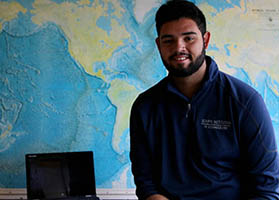
Casey Brayton is a junior at University of South Carolina majoring in marine science and applied mathematics. Co-mentored by Scripps professors Sarah Gille and Lynne Talley in a collaborative project with researcher Matt Mazloff and University of Washington graduate student Ethan Campbell, Brayton used the Southern Ocean State Estimate (SOSE) to investigate circumstances leading to the extraordinary formation of the Maud Rise polynya. This polynya, first spotted in the 1970s and seldom seen again until 2016, plays a unique role in water mass formation and carbon sequestration in the Southern Ocean. Her favorite part of being a SURFer was snorkeling with the leopard sharks in La Jolla Cove and working with the incredible scientists at the Southern Ocean Carbon and Climate Observation and Modeling (SOCCOM) project. In the future, Brayton plans to continue her exploration of the Southern Ocean in graduate school at Scripps.

Jeramy Dedrick is a fourth-year student at Texas A&M University majoring in Meteorology and Ocean Science & Technology. He has always had a passion for atmospheric sciences, oceanography, chemistry, and climatology. This made him a perfect match to join the atmospheric aerosol research group led by Scripps researcher and professor Lynn Russell. In Russell’s lab, Dedrick is using humidified tandem differential mobility analyzer data to analyze hygroscopic aerosol particle growth in the West Antarctic region to determine cloud activation properties and particle compositions for the AWARE (ARM West Antarctic Radiation Experiment) campaign to understand the roles these properties will play in Antarctic climate change. Dedrick was excited to use his programming knowledge to develop skills in analyzing and modeling large data sets, which is necessary as he begins his journey towards a career in atmospheric dynamics and climatological research.

Jimmy Ge is a junior at the University of Miami (UM) studying meteorology and mathematics. His devotion to marine and atmospheric science and his earlier research project at UM involving atmospheric chemistry and aerosols inspired him to join the SURF program. He is working with scientist Vicki Grassian and graduate student Ellen Coddens to study reactions involving glyoxal that form organosulfates and imidazoles, and whether these reactions could be catalyzed by transition metals found in mineral dust. Using skills he gained in the SURF program, from instrumentation to communicating science, Ge plans to study hurricanes and atmospheric dynamics in graduate school and perform public outreach related to severe weather events and climate change.

Caitlin Glennon is a senior at St. Olaf College where she is double majoring in physics and mathematics. A Minnesota native, Glennon has always had a passion for the outdoors that has inspired her to pursue a career in geoscience where she can combine her academic and personal interests. This summer Glennon had the opportunity to work with research physicist Dan Lubin and graduate student Ryan Scott on a project that involved characterizing weather patterns and cloud microphysics in Antarctica based on specific atmospheric regimes with the ultimate goal of improving notoriously tricky Antarctic climate models. Some of her highlights from this experience have been jumping headfirst into an unfamiliar academic field and jumping into action on the volleyball court for some friendly SURF games. In the future, Glennon plans to continue her education in graduate school by pursuing a PhD.
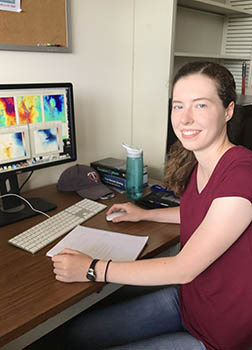
Justin Higa is a fourth-year student at the University of Hawai’i at Mãnoa, where he is majoring in geology and geophysics. During the SURF program, he worked in the paleomagnetism lab of Lisa Tauxe, a distinguished professor of geophysics at Scripps. In the lab, he worked under the guidance of scientist Shuhai Cai, who’s life work is in establishing geomagnetic reference curves for Asia. Higa was tasked with analyzing archeological samples from ancient Cambodian iron smelting mounts, which contain magnetic minerals that recorded the historical strength of Earth’s magnetic field under which they were fired. This data will be used to initiate a paleointensity curve of the geomagnetic field during the Holocene in Cambodia. One of Higa’s favorite parts of the SURF experience was bonding with other SURF and UC San Diego students in the lab while his rock samples were “baking.” As a result of the SURF program, Justin is now seriously considering graduate school in geophysics as a path to his future career.
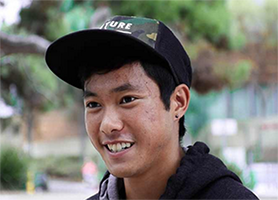
Irazema Islas, a fourth-year student at San Diego State University, is majoring in chemistry with an emphasis in biochemistry. Her passion for research led her to apply to the SURF program. Islas is working in the lab of Professor Lihini Aluwihare under the guidance of PhD student Irina Koester. Islas' work consisted of observing the effect of the neurotoxin domoic acid on phytoplankton growth rate. Certain diatoms of the genus Pseudo-nitzschia produce domoic acid, causing harmful algal blooms (HABs). The reasons for toxin production are still not well understood. In an experiment, Islas examined the effect of domoic acid on the growth rate of toxic and non-toxic Pseudo-nitzschia species as well as other phytoplankton species. Islas was excited to learn new techniques and gain experience that she will take away to her home institution. After graduating from college she plans on pursuing a PhD in a chemistry-related field.

Kevin Kelley is a senior at Texas A&M University at Galveston where he is studying marine science with minor in geology. Kelley has had an interest in natural science since a young age, and his time as a United States Marine at Camp Pendleton, Calif., helped foster a love for the ocean. In the SURF program, Kelley worked with paleobiologist Dick Norris on a new geochemical method to infer ancient ocean productivity. He tested the hypothesis stating ocean productivity was much higher during the last greenhouse period, ~50-55 million years ago, than it is today. This study tests the hypothesis that the oceans of a warmer future will have lower biological productivity than today. Kelley plans to further his scientific knowledge through the pursuit of a Master of Science in earth science while focusing on paleoceanography.

Isaiah Klimek is a fourth-year student at Virginia Commonwealth University majoring in biology and chemistry with a minor in math. The SURF program has allowed Klimek to take on research for the first time, bringing new light to his love and curiosity for the ocean. Diving into research has offered Klimek hands-on experience from taking care of marine organisms to learning useful skills in the lab. He researched in the lab of scientist Dimitri Deheyn, studying mechanisms of bioluminescence of the deep-sea octocoral Umbellula. Before the opportunity to participate in the SURF program, Klimek was heading towards a career in the medical field, but now has changed trajectory towards achieving a doctorate in science after being exposed to the infectious love for research and for the ocean during his time at Scripps.

Magdalena Lara is a senior at California State Dominguez Hills pursuing a bachelor’s degree in molecular biology with a minor in biochemistry. She has two main passions: the ocean and asking “why?” It was the pursuit of these passions that led Lara to the tremendous opportunity of working with marine microbiologist Paul Jensen under the mentorship of Kaitlin Creamer through the SURF program. During the summer program, Lara said her world was expanded through a better understanding of the microbial life in the ocean. She was fortunate to develop skills in marine microbiology and the natural products chemistry fields. She aspires to pursue her PhD in this interdisciplinary field, to one day inspire other young scientists to do the same, and to find more answers for the question “why?”

Dede Lawal is a rising junior majoring in environmental science at Emory University. Her love of the ocean is the reason she applied to the SURF program, where she was placed in the marine bioacoustics lab of marine bioacoustician Ana Širović. In the lab, Lawal analyzed the variability of blue whale song patterns along the northeastern Pacific, hoping to discover whether these blue whales were from the same or different populations. Her favorite part of the SURF program was walking into the lab every day and feeling the support and respect everyone had for one another. In the future, Lawal plans on earning her bachelor’s degree and then attending graduate school to pursue a higher degree and continue her academic career.

Kayla Martinez-Soto is a senior at Northeastern Illinois University majoring in environmental science. This summer, Martinez-Soto worked under the mentorship of scientist Brice Semmens and PhD student Lynn Waterhouse. Martinez-Soto analyzed different methods of collecting eggs from spawning Nassau and Tiger Grouper. She specifically tested if they affect fertilization rates and egg morphometry. Martinez-Soto's interest in science came at an early age, as she grew up between the urban city of Chicago as well as a rural town in Puerto Rico, where she observed how anthropogenic practices greatly impact surrounding landscapes and biodiversity. She is currently in the process of applying to graduate school to pursue her research interests in conservation of freshwater mussels and reach her career goal of working as a government scientist.

Ivan Moreno is a senior at California State University, Dominguez Hills, majoring in biology with a concentration in cellular and molecular biology. He said the SURF program has served as the perfect platform to further advance his ever-growing interests in microbiology. Moreno conducted research work in the lab of marine biologist Brian Palenik, where he had the opportunity to expand on his previous microbiology research experience and venture into the world of cyanobacteria, diatoms, and other thermophilic microbial life. Moreno focused on characterizing the microbial community of the hot springs in the Black Canyon of the Colorado in Nevada by conducting the 16S rRNA sequencing of various isolated microbial organisms. In addition, he examined the interactions between cyanobacteria and diatoms found in these hot springs. Moreno noted that being able to dive into the world of extremophile microbes under the guidance of Palenik was a “huge stride” in his long-term goal of studying extremophiles as a PhD student in the coming year.
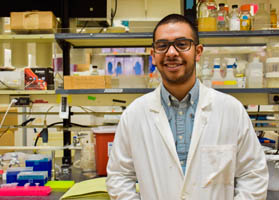
Tia Rabsatt is a junior attending the University of the Virgin Islands with aspirations of becoming a marine biologist. Her passion for learning more about various marine ecosystems led her to develop interests in research and she was thrilled to be given the opportunity to join the SURF program. At Scripps, she worked in the lab of scientist Jeff Bowman on a project investigating the marine microbial ecology of seagrass in San Diego Bay, specifically to study the relationship between seagrass and pathogenic microorganisms. The main objective of the project was to determine if seagrass ecosystems could reduce the presence of pathogenic microorganisms such as enterococci in San Diego Bay, as well as to examine the bacterial community in areas with presence and absence of seagrass. The results from this project can help understand microbial communities in seagrass beds and the impacts they could have in filtering pathogens. This is important because seagrass ecosystems may have the potential to mitigate diseases and can be used as a buffer of diseases for other organisms such as coral reef ecosystems.

Daniel Smith is a senior at Sonoma State University in Northern California where he is studying physics and music performance. His interest in physics and passion for nature led him to the field of physical oceanography. Smith was placed with scientist Falk Feddersen at the Center for Coastal Studies where he studied nearshore physical interactions in the ocean. Under the mentorship of Feddersen, Smith developed research skills, improved his computational and programming abilities, and was immersed in the field. His work included research of internal waves and overturn in the region between Scripps Pier and Scripps Canyon offshore. Smith plans to continue studying in the ocean sciences at the graduate level.

Jaxine Wolfe is a senior biology student from Northeastern University. She is thrilled to participate in this year’s SURF program and have the opportunity to work in the lab of Lisa Levin, a distinguished professor of integrative oceanography at Scripps. Under the mentorship of Natalya Gallo, a PhD student in the Levin lab, Wolfe has been investigating the temporal dynamics and trophic structure of a demersal fish community that is resident to an oxygen limiting zone in the Southern California Bight. When she is not in the lab, Wolfe has greatly enjoyed exploring the vibrant city of San Diego, learning how to surf, partaking in research cruises, and meeting inspiring people with a likeminded passion for science. In the fall, she will be studying abroad through her university, taking classes and conducting research at the Friday Harbor Laboratories in Washington and the Smithsonian Research Institution in Panama. In the future, she hopes to find an engaging career path that will provide opportunities to influence both science and policy.

India Dove is a junior at the University of California San Diego pursuing a bachelor’s in marine biology. This summer, Dove worked in scientist Brice Semmens’ lab under the guidance of graduate student Brian Stock. Dove conducted a length-frequency analysis of a Nassau Grouper spawning aggregation off Little Cayman Island using underwater laser caliper video collected in February 2017. The intent of the research is to understand the size structure of the Nassau Grouper spawning stock to see if the species is recovering, in the form of new recruitment, from historical fishing exploitation. Her favorite part of the SURF program has been the process of overseeing a small research project through to completion in phases: literature review, data compilation and analysis, and the poster presentation. In the future, she aspires to attend graduate school to earn her PhD in marine science. Her research interests include quantitative and spatial ecology, conservation biology, fisheries management, and environmental policy.
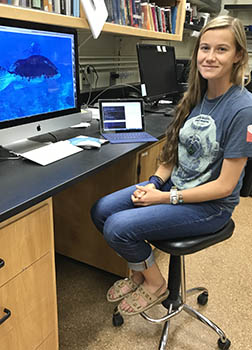
Zoe Burns is a junior at New Mexico State University where she is pursuing a degree in physics. In the SURF program she worked with scientist Jeff Gee on paleomagnetic research, specifically learning to create models with computer code. The aim of the project was to use demagnetization data from slowly cooled igneous rocks to create a time series of magnetic field variations in the early Jurassic. The relevance of the work lies in the novel use of an igneous intrusion and in providing possible evidence for the relationship between field intensity and reversal frequency. After completion of the program, Burns hopes to continue her forays into different areas of scientific research, in preparation for applying to graduate school.

Omar Rosales is a junior at the University of California Santa Cruz studying earth sciences. This summer he worked under Professor Jane Willenbring to look at the surface processes in Puerto Rico. His favorite of the program was conducting field work in Puerto Rico, where he collected data from the island’s rain forest. Using bedrock samples from a watershed, he measured the erosion rates of weathering oddities known as gnamma pools to help understand their role in the eroding system. With his new experiences and knowledge, Rosales is determined to continue unraveling the mystery of how landscapes evolve.

Zandria Acosta is a senior at the University of the Virgin Islands where she is studying computer science. This summer she worked in scientist Stuart Sandin’s lab in collaboration with postdoctorate scholar Maya deVries. Acosta’s research project was to develop object recognition software that is capable of recognizing and identifying coral species with a set of data. The SURF program has allowed her to have first-hand experience with the collaborative work between Scripps and Jacobs School of Engineering. Acosta hopes to apply the research experience she received at Scripps towards her graduate studies in software engineering.

Lennon Bruney is a senior at the University of the Virgin Islands (UVI) in St. Thomas studying marine biology. At Scripps, Bruney worked under scientist Stuart Sandin, studying fish and coral ecology in the lab as part of the 100 Island Challenge project which monitors coral reef health on over 100 different islands or atolls across the Pacific Ocean. Bruney’s main focus was using 3D imaging to determine coral growth rates and reef rugosity to create a coral reef restoration program. His work sought to give answers on how the growth of coral can influence the complexity of reefs and what corals would be best to use for short-term and long-term restoration projects. Bruney’s favorite part of the program was interacting with different graduate students and mentors in the lab and participating in planned tours of the Southwest Fisheries lab at NOAA and Birch Aquarium at Scripps to hear different perspectives of how people who were once undergrads got to where they are today. The SURF program has now influenced Bruney to investigate coral reefs further and to use his knowledge to help protect these important ecosystems. After graduating from UVI, Lennon plans to take a year off from school and then pursue a PhD, hopefully at Scripps.

Amrit Bal is a senior of the University of Missouri where she is majoring in physics with minors in geology and mathematics. Her interest in earth science came from her goal to help people and make others’ lives better. Her research interests are focused on natural geological hazards, specifically earthquakes at convergent plate boundaries that have the potential to impact thousands of lives around the world. During the SURF program, Bal worked with Dave Stegman, associate professor of geophysics, to study the correlations between sediment and subduction parameters and used geodynamic models to investigate how sediments influence subduction dynamics. After graduating this fall, Bal plans to continue helping people by studying law and business.

Michelle Gess is a senior at the University of Wyoming majoring in geology. Gess grew up spending lots of time outside, creating an appreciation for nature and rocks. Her true passion for geology is rooted in the ability to learn concepts from textbooks and then go into the field and apply all the information. While working with Professor Jeff Gee through the SURF program, Gess was able to broaden her horizons within geology by studying the paleomagnetic signatures in samples collected from fast spreading oceanic crust. The analysis of samples can better constrain the temperature and time of cooling at fast-spreading ridges, a crucial part of plate tectonics. Gess’s favorite part of the SURF program was learning new lab techniques and working with professors and students who are passionate about their work. Gess plans to continue her education in geology in graduate school.

Josefa Muñoz is a biology major from the University of Guam. During the SURF program, Muñoz worked in the deep-sea microbiology lab of Professor Douglas Bartlett studying the effects of varying hydrostatic pressures and temperatures on members of the genus Carnobacterium. Carnobacteria have shown growth under both simulated low-pressure conditions found on Mars and high-hydrostatic pressures found in the deep sea. These microbes therefore represent interesting model organisms for evaluating the potential habitability of other planets, including those that have deep subsurface oceans. Muñoz evaluated the growth rates, cellular morphology, and fatty acid composition of Carnobacterium species at pressures representing up to 6000 m water depth. Muñoz’s passion for science originates from her Chamorro ancestral roots, which teaches that all of nature should be respected. With this upbringing, she plans to pursue a master’s degree in marine biology and work towards the conservation of endangered marine organisms.

Maya Chung is a junior at Harvard College majoring in earth and planetary sciences with a minor in mathematical sciences. Her childhood dream of being a physical oceanographer brought her to the SURF program, where she worked in the lab of scientists Lynne Talley and Sarah Gille on the Southern Ocean Carbon and Climate Observations and Modeling (SOCCOM) project. She used the Southern Ocean State Estimate (SOSE) model to analyze the physical mechanisms driving ice export out of the Ross Sea, particularly coastal polynya formation, katabatic winds, and the Amundsen Sea Low. These processes provide insight into recent large freshwater fluxes in the Southern Ocean and their implications for global ocean circulation and climate. Chung plans to continue exploring climate research to identify her interests, write a senior thesis, and attend graduate school to research paleoclimate and/or climate change’s impact on humans, such as food production or global health.

Kelly Devlin is entering her senior year at Temple University, where she studies physics and geology. Her initial experience with the SURF program was overwhelmingly positive, which caused her to return for a second summer with funding from her home university. She continued to work under the guidance of Scripps geophysicist Adrian Borsa, monitoring oil production in northeastern Wyoming using interferometric synthetic aperture radar (InSAR). This work improved her technical skills as well as reinforced her passion for geodesy and research. One of her favorite parts of the SURF program was meeting students from across the country with diverse scientific interests. Devlin eventually plans to continue her studies in earth science by pursuing a PhD.
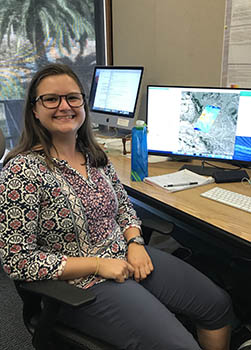
Bryant Jew is a junior at the University of California San Diego where he is majoring in marine biology and minoring in science education. His passion for biology and interest in research led him to apply for the SURF program, in which he was placed with scientist Deirdre Lyons. The Lyons Lab conducts evolutionary/developmental biology research, and this summer, Jew’s project utilized antibody staining and drug treatments to help describe mouth formation of slipper snails (Crepidula fornicata). Mouth formation in relation to the blastopore is not well understood in this Spiralian, and this investigation will enrich our understanding of mouth evolution. Jew greatly enjoyed his time in the Lyons Lab, and intends to continue in this lab throughout the school year as he explores the possibility of graduate school.
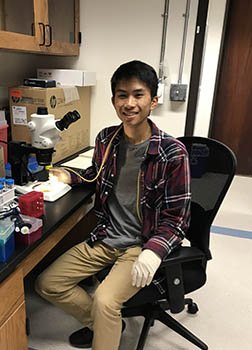
Greg Mamikunian is a junior at the University of California San Diego where he is majoring in earth sciences. In the SURF program this summer, he deepened his interest in the field of paleoclimatology working in the lab of Professor Chris Charles. Mamikunian’s research project involved reconstructing a high-resolution paleoclimate data set of oxygen isotopes from individual benthic and planktonic foraminifera from a high-resolution deep-sea sediment core near the output of the Zambezi River in Africa. The data was used to reconstruct climate variability, particularly to understand the effect of the El Niño system in the Holocene and Last Glacial Maximum. He really enjoyed the experience of delving deep into research and engaging in the “powerful process” of scientific collaboration. He also enjoyed surfing, working, and gaining valuable insight into the field of paleoclimatology while in sunny San Diego. Mamikunian plans to go to graduate school to get an MS or PhD and work in industry or academia.
